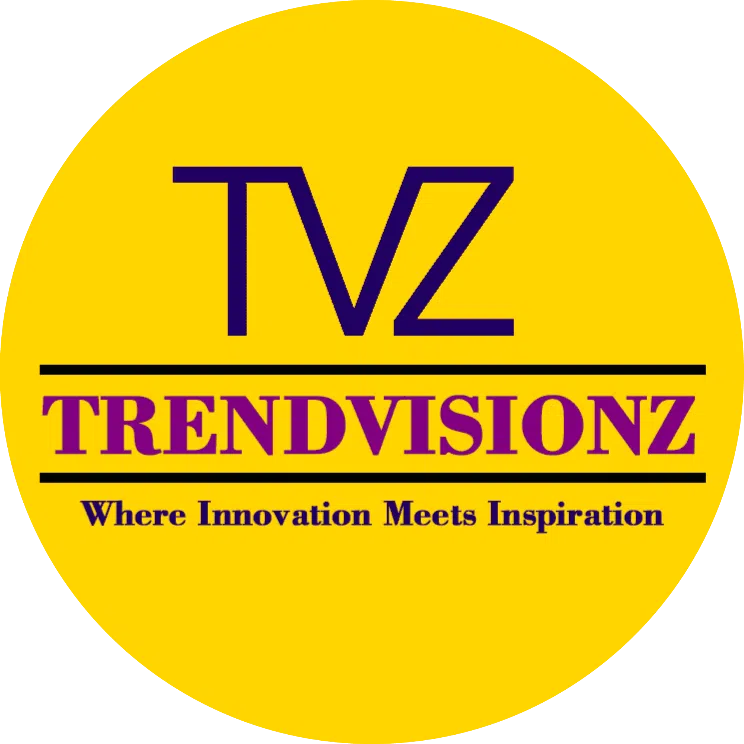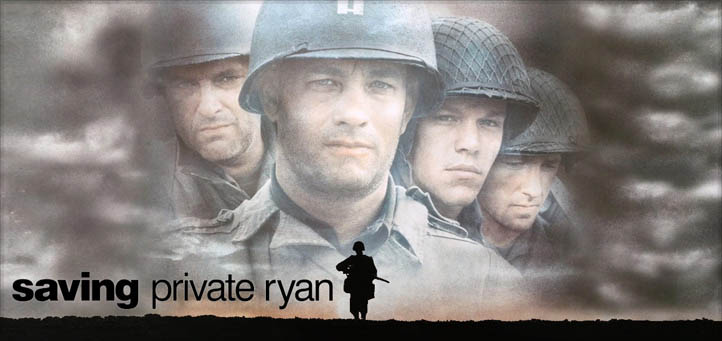Have you ever walked away from a conversation feeling unheard? Do you feel like you were talking to a brick wall? We’ve all been there. Getting your point across is essential. Effective Communication involves a balance between speaking and listening—monologue vs. dialogue. Work Life Balance Examples stand tall between your professional aspirations and personal contentment.

The art of Communication is the foundation of any meaningful connection. It thrives on a two-way street. Helping in exchanging information and ideas. It is the lifeblood of our personal and professional lives. Building relationships, solving problems, and navigating the world around us. Active listening can transform the way we communicate and connect with others
In this post, we’ll explore the continuum between monologue vs dialogue. And how to strike the right balance. You’ll learn techniques to cultivate effective Communication. Tips for the art of Communication like active listening and thoughtful questioning.
Let’s delve into how striking this balance can transform your Communication.
Also Read:
- Top Summer Places to Travel: You’ll Want to Book Now
- Empowered Women: Be Informed and Take Charge of Your Health
- Recharge, Refocus, Reimagine: Your Complete Guide To The 7 Types Of Rest
Monologue vs Dialogue: Defining the Key Differences
In the symphony of Communication, monologues vs dialogues play distinct roles.

Think of a tennis match . A monologue is like one player serving repeatedly. While dialogue is the back-and-forth volleys that create a dynamic game. Both have their place. Monologues offer a focused exploration of a character’s inner world. At the same time, dialogues reveal character relationships through interaction.
Understanding these differences is crucial for effective Communication. Both in crafting stories and navigating real-life conversations.
The Power of the Monologue: Delving Deep into a Character’s Mind
The monologue meaning a one-sided speech. The Greek word “monologos” translates to “speaking alone.” It refers to a lengthy speech delivered by a single person. Here, a single character delivers their thoughts, feelings, or experiences. Imagine a passionate lecture or a character lost in thought, talking to themselves. The monologue holds a unique and powerful space in storytelling.
In casual conversations, an unscripted monologue occurs when one person dominates the discussion. Without allowing others to take part. This behaviour can reveal a lot about the speaker and their conversational style. At the same time, some may engage in this behaviour. It can hinder effective Communication. And prevent others from sharing their thoughts and experiences.
Let’s explore the different types of monologues. And how they contribute to the art of Communication. Even within the context of monologue vs dialogue.
Types of Monologues
Have you wondered about different flavours of desserts? Monologues also come in various types. Each has its unique taste. Each type offers a distinct experience for both the speaker and the audience.
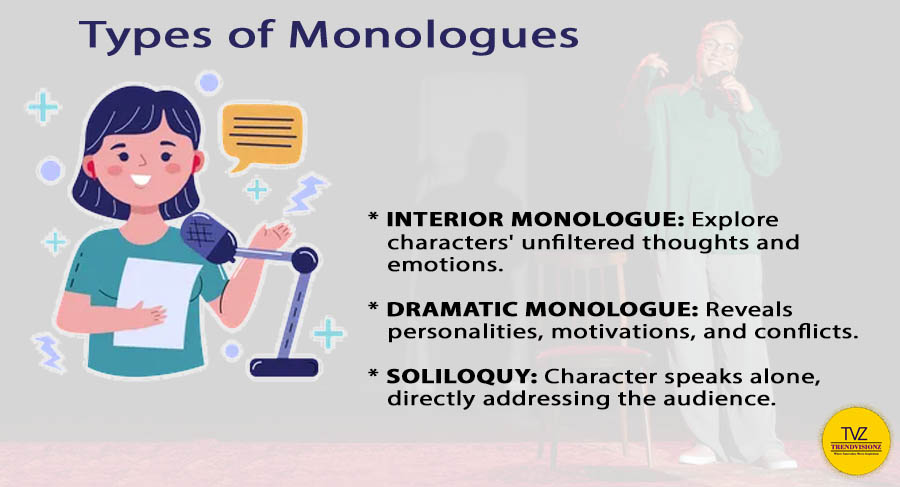
Interior Monologue
This dives into a character’s stream of consciousness. Portraying their unfiltered thoughts, memories, and emotions.
Dramatic Monologue
Here, a character addresses a specific listener (who might not be present). Revealing their personality, motivations, and inner conflicts.
Soliloquy
This is a monologue delivered by a character alone on stage. Directly addressing the audience.
Importance of Monologues
Monologues serve as powerful tools in storytelling. Offering a direct line into a character’s thoughts and emotions.
- Deep Dive into Character Psychology. Monologues allow for a focused exploration of a character’s thoughts and emotions. We gain a deeper understanding of their motivations, fears, and desires.
- Building Suspense and Foreshadowing. A well-crafted monologue can build suspense by hinting at future events. Or foreshadowing character development. This creates a sense of anticipation and dread for the audience.
- Creating Intimacy with the Audience. By granting access to a character’s inner monologue. They create a sense of Intimacy with the audience. There is a connection to their thoughts and emotions.
Examples of Monologues
Monologues are powerful tools offering deep insights into characters’ minds. Here, we explore examples of monologues showcasing their impact.
Literature
Consider Jay Gatsby’s extravagant monologue – The Great Gatsby by F. Scott Fitzgerald. It exposes his obsessive love for Daisy and the lengths he’ll go to win her back.
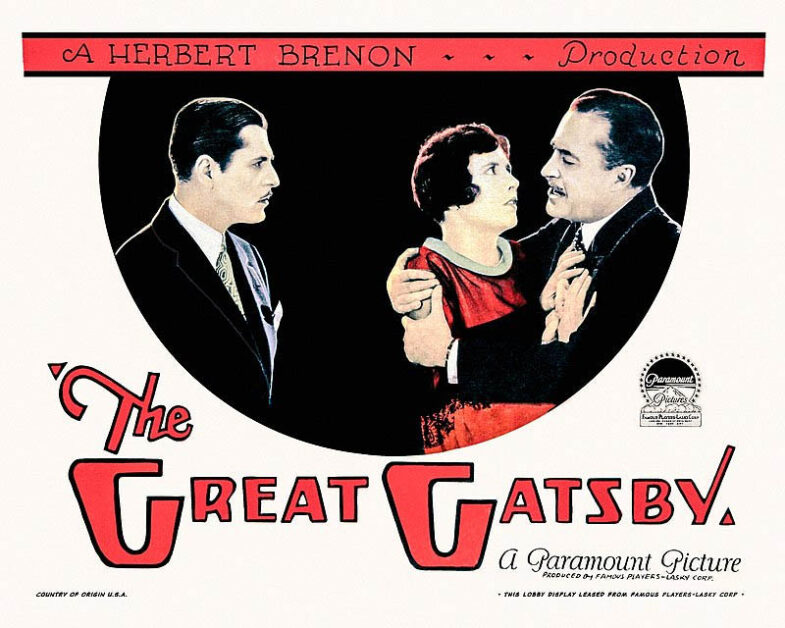
Film
Captain Miller’s inspiring speech before the D-Day invasion. In Saving Private Ryan is a powerful example of a monologue in film. It showcases his leadership, compassion, and the weight of responsibility he carries.
Personal Relationships
In personal relationships, Communication plays a vital role. They help in maintaining strong bonds and resolving conflicts. In the digital age, staying connected through various platforms allows for constant Communication. It’s essential to ensure that these interactions are meaningful and genuine.
At Workplace
In the professional world, effective Communication is vital to success. From conveying ideas to colleagues and clients. To negotiating deals and managing conflicts. Communication skills are essential at every level of an organization. The ability to communicate through digital channels has become important.
The monologue offers a unique perspective on the internal world of a character. In the grand monologue vs. dialogue, understanding is important. It allows creators to craft more prosperous, more impactful stories.
The Art of Dialogue: Weaving a Tapestry of Words
The dialogue is the lifeblood of storytelling. Dialogue refers to a discussion involving two or more individuals. It’s the give-and-take of ideas, reactions, and responses that drive a conversation forward.

What is Dialogue
Dialogue is the spark that ignites the plot. Reveals character depth, and transports readers or viewers into a vibrant world. Through conversation, writers and filmmakers breathe life into their creations. Fostering connections between characters and engaging the audience.
Functions of Dialogue in Daily Life and the Corporate World
Dialogue is for more than just crafting captivating stories. It’s the cornerstone of effective Communication in our everyday lives. Be it personal and professional.
Building Relationships and Understanding
Conversations are how we connect with others, share experiences. And learn about their perspectives. During a team meeting, colleagues discuss project updates, share ideas, and raise concerns. This open dialogue fosters collaboration. Helps to builds trust, and ensures everyone is on the same page.
Resolving Conflicts and Finding Solutions
Disagreements are inevitable, but dialogue is the key to resolving them. Imagine a a dispute between corporate colleagues about a project approach. The resolution of the conflict can be through open Communication. By discussing the pros and cons of each approach,. They can arrive at a beneficial solution.
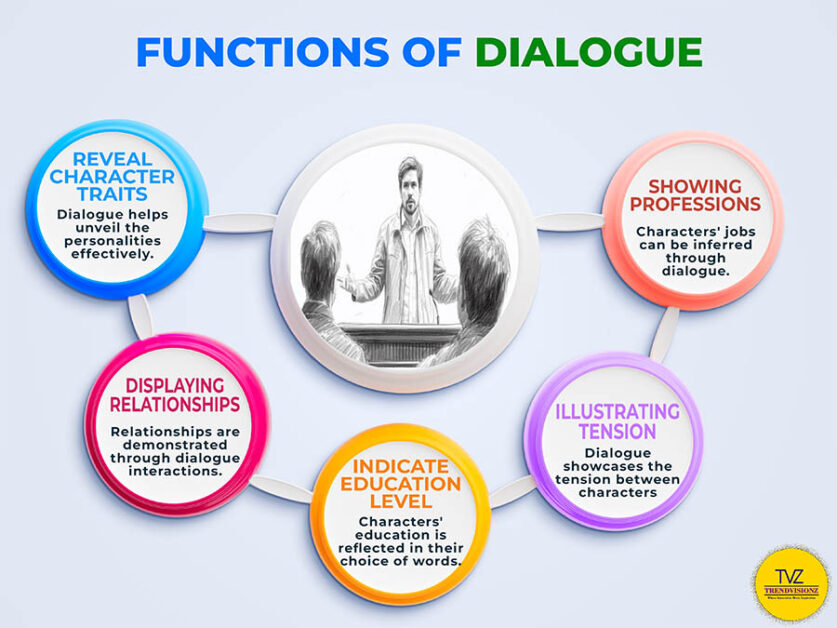
Persuasion and Influence
In many situations, we want to convince others of our point of view. Persuasive dialogue plays a crucial role here. Imagine negotiating a raise with your boss. By clearly articulating your values and achievements, you can influence their decision. A sales representative uses dialogue to present their product’s benefits. And convince potential customers to make a purchase.
Building Trust and Credibility
Effective trust-building relies on honest and open communication. Imagine a conversation between a parent and child. The child feels comfortable confiding in the parent. This open dialogue strengthens their bond and builds confidence. In the corporate world, leaders who communicate with their employees. They foster a more trustworthy and productive work environment.
Types of Dialogue in Daily Life and the Corporate World
Let’s understand the types of dialogues in our daily personal lives and the professional corporate world. Each serves a specific purpose:
Informative Dialogue
This type of dialogue aims to convey information. Imagine a conversation between a customer service representative and a client. The representative uses informative dialogue to explain a new policy. Or troubleshoot an issue or answer the client’s questions professionally.
During a team meeting, colleagues might use informative dialogue. To share project updates and present data. Or explain their roles and responsibilities within the project.
Relationship-Building Dialogue
This type of dialogue focuses on fostering connections and building rapport. Imagine chatting with a colleague at a company social event. You might discuss shared interests. Ask about their weekend plans, or exchange lighthearted jokes. This casual, relationship-building dialogue helps create a more positive and collaborative work environment. A friendly conversation with a neighbour can strengthen your connection within the community.
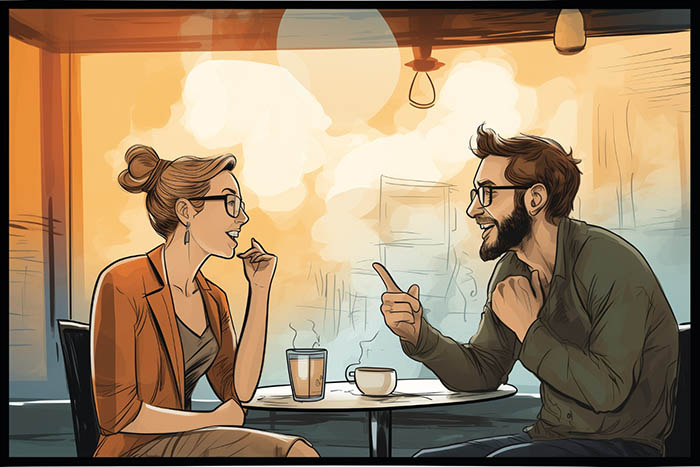
Types of Dialogue in Daily Life: Nurturing Connections and Understanding
Persuasive Dialogue
Sometimes, we need to convince others of our ideas or proposals. Persuasive dialogue plays a crucial role here. Imagine a salesperson presenting their product to a potential client. They’ll use persuasive dialogue. To highlight the product’s benefits. Address any concerns, and convince the client to make a purchase. During a negotiation, persuasive dialogue allows both parties to present their arguments. Find common ground, and reach a beneficial agreement.
Conflict Resolution Dialogue
Disagreements are inevitable, but dialogue is the key to resolving them. Imagine a team encountering a roadblock in their project. Through conflict resolution dialogue, they can openly discuss the issue. Brainstorm solutions, and find a way to move forward. This type of dialogue focuses on active listening. Understanding different perspectives, and finding a compromise that works for everyone involved.
Dialogue examples: Personal and Professional World
Meanwhile, the essence of natural language remains essential. Crafting effective dialogue in daily life. And the corporate world requires a different approach.
“How about we meet up at the park tomorrow?,” said Sarah.
“Sounds good,” replied Tom, “What time?”

This dialogue example illustrates simple planning.
Elevating Conversations: The Art of Engaging Dialogues
Mastering dialogue involves more than just speaking. It’s about clarity, context, active listening, and impactful body language. Thus enhancing personal and professional interactions.
Clarity and Concision
Strive for clear and concise Communication. Avoid jargon or complex sentences that might confuse the listener. Imagine a manager delegating tasks to their team. Their instructions should be clear. Outlining expectations and deadlines without unnecessary ambiguity.
Context is King
Tailor your dialogue to the specific situation and audience. In a casual conversation with a friend, you might use informal language and humour. But, during the business presentation, you’d use professional language. And present a more formal tone.

Active Listening and Responsiveness
Effective dialogue is a two-way street. Pay close attention to the other person and respond thoughtfully.
Body Language Matters
Nonverbal cues play a significant role in Communication. Maintain eye contact, use appropriate gestures, and project a confident demeanour. Imagine a job interview. Your body language should convey professionalism and enthusiasm alongside your spoken words.
By following these tips, you can transform your conversations. Engaging and productive dialogues, both in your personal and professional life.
Dialogues Examples: Effective in the Personal and Professional World
Understanding the differences between monologue vs dialogue can significantly improve your communication skills. The Dialogues allow for the sharing of multiple perspectives, leading to a richer understanding of a topic or issue. This can lead to better decision-making and problem-solving.
Personal World
- Two friends catching up: “Hey, how was your Italy trip? Did you get a chance to try out that gelato spot I suggested?” (Relationship-building dialogue)
- Parent-child conversation. “I understand you’re upset about missing the game. But let’s talk about how you can handle your disappointment.” (Conflict resolution dialogue)

Professional World
- In a team brainstorming session. “I like your idea of leveraging social media for our marketing strategy. How can we integrate it with our current strategy?” (Informative & persuasive dialogue)
- Client meeting: “Thank you for presenting your proposal. We appreciate your understanding of our needs. Let’s discuss the next steps.” (Clear & concise dialogue)
The 85/15 Rule: Are You a Monologue Machine?
Have you ever noticed conversations feeling lopsided. With one person dominating the talking while others need help to get a word in? There’s a scientific reason for this. The 85/15 rule suggests that in many conversations, people spend around 85% of the time talking about themselves. And their viewpoints, leaving only 15% for listening to others. This monologue-heavy approach can hinder connection and create misunderstandings.
Monologues lack empathy and connection
When we dominate the conversation. We fail to gain other perspectives and truly understand different views. This limits our ability to build rapport and find common ground. Dialogue is a two-way street. That fosters understanding and brings people together.
Also Read:
Using the GROW Model to Enhance Dialogue
The GROW model serves as a valuable framework for skill-building in Communication. Let’s explore how we can use each component of the GROW model. And avoid the pitfalls of monologues:
Goal: Establishing the Purpose
Before engaging in a dialogue, clarify the goal or purpose of the conversation. This sets a clear direction and ensures both parties are aligned in their objectives. For example, if you’re discussing a project with a colleague. The goal might be to brainstorm ideas for improvement.
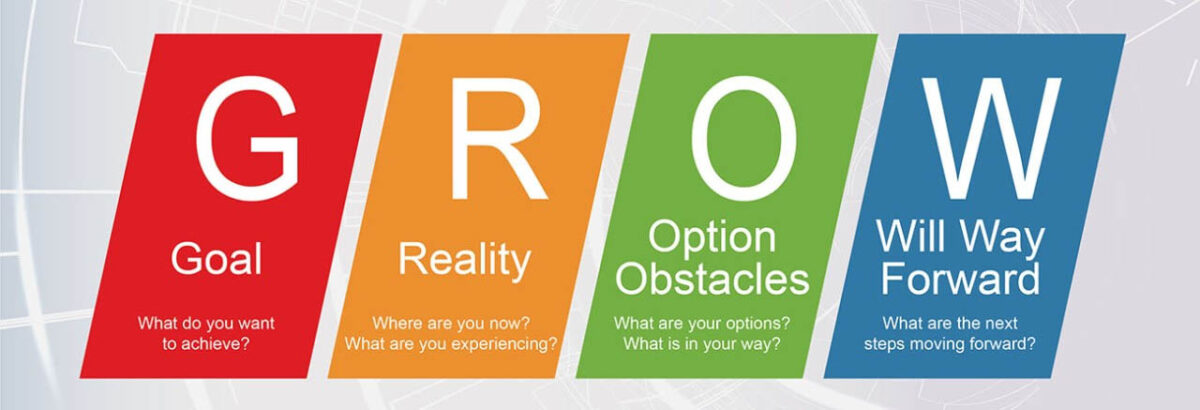
Reality: Understanding the Current Situation
Listen actively to understand the other person’s perspective. This involves asking open-ended questions. And reflecting on what you’ve heard to ensure mutual understanding. Acknowledge their feelings and experiences to build empathy and connection.
Options: Exploring Alternatives
Encourage a collaborative approach by exploring various options or solutions together. Avoid imposing your ideas . And, instead, invite the other person to contribute their thoughts. This fosters a sense of ownership and engagement in the dialogue.
Will: Committing to Action
Finally, agree on a course of action based on the insights and options discussed. Ensure that both parties commit. And agree-upon actions and set clear timelines and responsibilities.
Incorporate the GROW model into your dialogues. You can create more empathetic, engaging, and purposeful conversations. This enhances understanding and builds stronger relationships. The GROW model emphasizes the importance of dialogue over monologue. Monologue vs dialogue understanding helps promoting active listening and balanced communication for personal and professional growth.
The Role of Mindfulness in Communication
Communication is most effective when we are fully present. This means minimizing distractions . And being mindful of how our words and actions affect others. Approach each conversation with empathy, caring, and compassion. Ability to connect with one another is what allows proper understanding and transformation.
Aim for a 60/40 or even 50/50 split between talking and listening. Foster more meaningful conversations and build stronger relationships. Remember, Communication is a two-way street!
Shifting from Monologue to Dialogue: The Listen-Ask-Speak Approach
Monologues do have their place. Especially in situations where information needs to be delivered quickly. In most professional scenariosleaders prefer dialogues. Due to their collaborative nature and potential to foster stronger relationships. A recommended approach to shift from monologue to dialogue communication. Follow the Listen-Ask-Speak method.
Listen
Active listening is the first step in turning a monologue into a dialogue. It involves paying full attention to the speaker,. Understanding the information they are sharing. And refraining from interrupting. By actively listening, you demonstrate respect for the speaker’s perspective. And create a foundation for meaningful interaction.
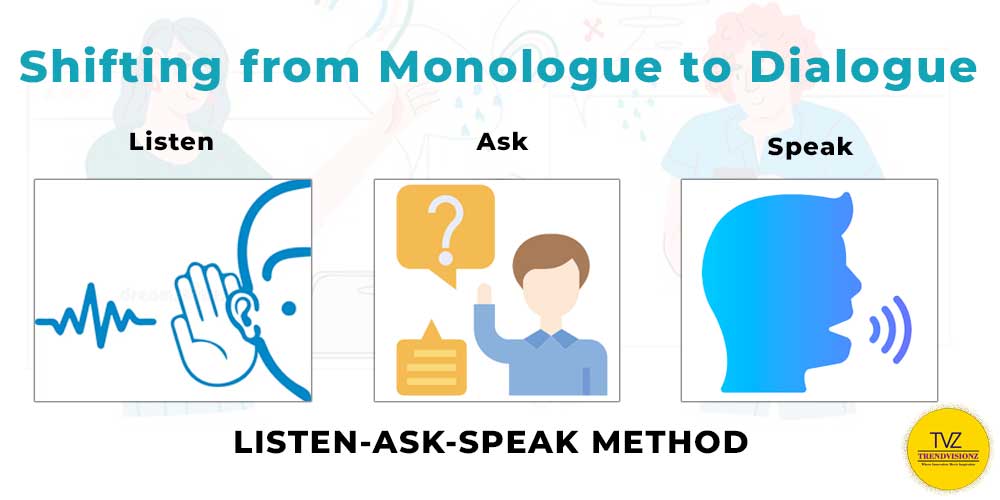
Ask
Asking questions not only shows that you’re interested and engaged. But it also encourages the other person to share more about their thoughts and ideas. It’s a simple yet effective way to turn a one-sided conversation into a two-way dialogue. Asking open-ended questions can help elicit more detailed responses.. Fostering more profound understanding and connection.
Speak
Once you’ve listened to the speaker and asked relevant questions, it’s your turn to speak. However, effective Communication is about more than dominating the conversation. It is about contributing valuable insights and fostering a meaningful exchange of ideas. Share your thoughts and perspectives. But also be open to feedback and alternative viewpoints.
The Impact of Monologue vs Dialogue in the Workplace
Choose the type of Communication to use in the workplace. It can impact your relationships and work environment.
Monologue and their Effect
Monologues can be helpful in certain situations. Such as delivering a presentation or briefing a team. They can also create barriers when used in day-to-day conversations. Monologues can lead to a lack of engagement. Reduced team collaboration, and even foster a toxic work environment.
Dialogues and their Benefits
Dialogues foster inclusion, increase engagement, and promote a culture of collaboration. By engaging in dialogues, we allow everyone to contribute their ideas. It leads to more innovative solutions and more robust team cohesion. Embracing the Listen-Ask-Speak approach. And prioritizing dialogue over monologue. It can lead to more effective Communication and better outcomes in the workplace.
The Spark of Inquiry: Asking Questions to Ignite Dialogue
Great conversations aren’t born from pronouncements but from inquiry. Asking thoughtful questions is the art of a master communicator. It shows interest, encourages elaboration. And steers the conversation towards a more profound understanding.

Open-ended questions, like “What brought you to this perspective?” spark exploration and keep the dialogue flowing. Become skilled questioners. You can become better listeners and unlock the true power of dialogue.
Also Read:
Finding Harmony: The Power of the Well-Placed Monologue
Communication thrives on dialogue, but well-placed monologues can also be practical tools. Imagine a passionate teacher delivering a captivating lecture. Or a politician outlining their vision in a powerful speech. These are monologues, yes, but they serve a purpose:
- Conveying Information. An explicit monologue can deliver complex ideas or instructions, especially for large audiences.
- Evoking Emotion. A heartfelt monologue can move and inspire, as in a motivational speaker’s address.
- Building Suspense. A well-crafted monologue can leave the audience wanting moree. Creating anticipation for the unfolding dialogue.
The key lies in balance. Monologues should complement, not replace, dialogue. When used strategically. They can enhance Communication. By delivering focused information or igniting emotions. That can fuel richer dialogue to come.
Mindfulness: Enhancing Communication with Presence
Communication thrives on mindfulness, the practice of being fully present in the moment. Unlike multitasking during a conversation, mindfulness allows us to listen and connect. This fosters a more open and authentic dialogue.
Here’s how mindfulness elevates Communication:
- Focus. By quieting internal distractions. Genuinely focus on the other person’s message, both verbal and nonverbal.
- Empathy. Mindfulness allows us to be more present to the speaker’s emotions. Fostering compassion and understanding.
- Clarity. When mindful, we can express ourselves with greater clarity. And avoid misunderstandings caused by scattered thoughts.
Mindfulness transforms Communication from a mechanical exchange to a meaningful connection. It allows us to be present, listen deeply. And connect authentically. Leading to stronger relationships and more effective Communication.
Active Listening: Power Tool in Communication
Effective Communication is a two-way street. And active listening is just as essential as speaking.
Active listening is a communication skill that requires full concentration, understanding, response, and retention of the information conveyed. It’s a method of listening and responding to someone else that enhances mutual understanding.

Unlike a monologue, where one person delivers a message without exchange. Active listening fosters dialogue, a back-and-forth conversation.
Here’s how active listening is critical:
- Understanding: By active listening, we grasp the speaker’s message, not just the words. This prevents misunderstandings, the bane of many interactions.
- Confirmation. Techniques like paraphrasing (“So you’re feeling frustrated?”). And asking clarifying questions ensure we’ve understood the speaker’s intent.
- Engagement. Active listening shows the speaker we value their message. Encouraging them to share more openly.
This creates a richer dialogue where both parties feel heard and understood. Through active listening, effective Communication becomes a collaborative effort. Leading to stronger relationships and better outcomes.
Building Rapport: The Foundation of Effective Communication
Rapport is the feeling of connectio. And mutual understanding that paves the way for effective Communication. It’s the difference between a monologue delivered to a passive audience. And a genuine dialogue where both parties feel heard.
Dialogue is crucial for building rapport. By active listening and engaging in conversation, we show genuine interest in the other person’s perspective. This fosters trust and a sense of shared space where ideas can flow freely.

Here are some tips to build rapport during dialogue:
- Mirroring body language. Subtly mirroring the other person’s gestures (without mimicking) creates a sense of connection.
- Maintaining eye contact: This shows attentiveness and respect.
- Using open-ended questions: Questions like “Can you tell me more about that?” encourage elaboration and deeper conversation.
Building rapport takes time and effort, but the rewards are significant. Strong rapport fosters trust, collaboration, and, ultimately, success in Communication.
Dialogue: Bridging the Gaps
While dialogue fosters understanding, several barriers can hinder it. Cultural differences can lead to misunderstandings in communication styles or interpretations. Personal biases can also cloud judgment. Making it difficult to see things from another’s perspective.
Overcoming these barriers requires openness and empathy.
- Open-mindedness: Be willing to consider viewpoints different from your own. Listen actively, avoid interrupting, and seek to understand the reasons behind someone’s perspective.
- Empathy: Try to see things from the other person’s viewpoint. Consider their experiences and background, and acknowledge their feelings.
By practising these strategies, we bridge these gaps. And create a safe space for genuine dialogue. Fostering stronger connections and a richer exchange of ideas.
Feedback: Fueling Effective Communication
Feedback is the cornerstone of growth in the art of Communication. It allows us to understand how our message is received. And make adjustments for better clarity. With a dialogue that allows for feedback. Communication becomes a two-way street, limiting its effectiveness.
Dialogue is essential for feedback. It facilitates a back-and-forth exchange of ideas . Bboth parties can express their perspective. This allows for constructive feedback. The message is clear, and the focus is on improvement.
Here are some tips for effective feedback in a dialogue:
Giving feedback
- Focus on behaviour, not personality. (The report can be improved with clearer data.” Vs. “You could enhance your report writing skills)
- Be specific and actionable. (“The conclusion needs stronger evidence” vs. “The conclusion is weak.”)
- Offer help and support. (“Would you like me to help you find the data?”)

Receiving feedback
- Listen actively and avoid interrupting.
- Ask clarifying questions if needed.
- Be open to suggestions and show appreciation.
By following these tips within a constructive dialogue. Understanding the difference between monologue vs dialogue is crucial for giving and receiving feedback effectively. Feedback becomes a powerful tool for growth and effective Communication.
Also Read:
- Secrets & Symbolism: Demystifying Traditional Indian Jewelry
- Redefining Luxury: How NRI’s are Investing in Premium Homes in India
- Top Agritech Startups Fueling Agriculture Growth in India
FAQ: Monologue vs Dialogue
What is a monologue?
A monologue is a speech or presentation by a single person. Often used in storytelling, theatre, or public speaking.
How is a monologue different from a dialogue?
Understanding monologue vs dialogue is vital. A monologue involves one person speaking. The dialogue is a conversation between two or more people.
Why is dialogue critical in Communication?
Dialogue allows for the exchange of ideas, perspectives, and information. Leading to better understanding and connection between individuals.
When is it appropriate to use a monologue?
Monologues are helpful for presentations, storytelling. Or when one person needs to convey information. Express thoughts and feelings without interruption.
Conclusion
You have gotten this far, so you know communication is an art with many dimensions. The words we use are only part of effective Communication. Monologue vs dialogue allow for open and honest communication, which can help in finding common ground and resolving differences.
In the in-depth article, we explores the meaning of monologue. Also examined the examples of monologue to gain deeper insights. Understanding “what is dialogue” is essential for fostering collaboration among individuals.
Effective Communication transcends the monologue vs dialogue debate. While monologues excel at delivering information or igniting emotions. Genuine connection flourishes through dialogue. Mastering the art of active listening can lead to more meaningful relationships. It helps foster empathy. We transform conversations into enriching exchanges. Remember, Communication is a two-way street. Let’s strive for a harmonious balance. Where well-timed monologues pave the way for engaging dialogues. The art of communication helps to strengthen relationships and achieving goals.
The quality of your effective communication depends on it. When you make space for others to share freely, everybody wins.
Share your Review
Our Digital Imprints:
About the Author: Anuj Mahajan is a Mass Communication Specialist, ICF Certified Coach & Corporate Trainer. Motivational Speaker / NLP Lifecoach. With expertise spanning filmmaking, business coaching, motivational speaking, blog writing, and authoring, he embodies versatility and mastery across diverse fields.
Chief Operating Officer: Nuteq Entertainment Pvt Ltd, and Co-Founder: Trendvisionz – A Premier Digital Marketing Agency in India
Get Connected to us with our Newsletters- Transforming Lives… Creating the magic. Just – Believe ~ Practice ~ Perform BizTech Chronicle… Navigating Tomorrow’s Tech Frontiers 🚀
Join my LinkedIn Group: Digital Marketing, Content Creation World Group
Follow me on Twitter or LinkedIn. Check out my website.
